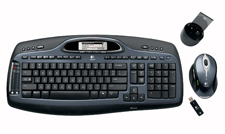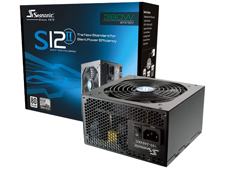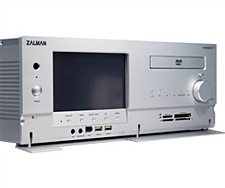Of Mice, Keyboards, and Enclosures
Input devices are one of the more interesting aspects of our roundup as the sheer amount of mice and keyboards available makes it virtually impossible to test every combination. Also, the very subjective nature of testing these devices leads us to always offer the advice of "try before you buy". We decided our best course of action was to select a few of the top selling products and then test their capabilities under Vista. What we found was quite surprising as several of the products proved to us that "Vista Certified" can in fact mean "Vista Disaster".
As an example, for our HTPC platform choice we decided a Bluetooth capable mouse/keyboard combination would offer the best compromise for the sofa users. This led us to the
Microsoft Wireless Entertainment Desktop 7000 and
Logitech Cordless Desktop MX 5000 Laser Combo as our two choices, neither one being anything near inexpensive. What surprised us was the number of issues we had with the Logitech choice. Most of the issues centered on the Logitech having to use the Microsoft Bluetooth stack, but in our opinion there is no way this product should have received the Vista Certified label.
For our standard wireless combinations we selected the
Logitech Cordless Desktop Comfort Laser,
Logitech Cordless Desktop MX 3200 Laser, and the
Microsoft Wireless Optical Desktop 4000. Of course there are multitudes of different wireless keyboards and mice that can be combined together depending upon your likes or dislikes as a user. For simplicity we decided to go the package route - which sometimes works and sometimes doesn't, as we will find out in our separate reviews.
Except for HTPC work, we really prefer the wired keyboards and mice with one of our favorite combinations being the Microsoft
Natural Ergonomic Keyboard 4000 or Microsoft
Comfort Curve Keyboard 2000 paired with the
Logitech MX-518 mouse. We like the MX-518 so much that most of our work desktops use it; it is just that good. As far as our gaming platform is concerned we will test the following keyboards:
Razer Tarantula,
Saitek Eclipse, and of course the
Logitech G15. We will look at
Creative's product lineup later on in the year. Our gaming mice consist of the
Logitech G5,
Razer DeathAdder, and the
Razer Diamondback 3G. Unfortunately, we will have to wait a bit longer before the new Logitech G9 mouse arrives in the labs.
Power supplies are another area where the sheer number of choices and price ranges make it difficult to choose a product. Our thought process in choosing a power supply is to think about the power requirements of your current system and probably the next one or two systems you plan on building. Besides the monitor, the power supply is one of those items that can potentially last through a couple of system builds. We typically tailor our budget to afford the best possible power supply on the market at that time.
Considering our power requirements with the µATX platform are not going to be that great as CrossFire/SLI are out and typically the number of drives and peripherals will be limited by the small form factor, we believe something in the neighborhood of 380W to 480W should be acceptable for now and the near future. We also want a unit that is energy efficient and quiet so our logical choice is the
SeaSonic S12 II 380W. We have not found a combination in our roundup testing yet that would cause us to seek a higher wattage unit. SeaSonic's own S12 II 430W would be the next logical choice but we felt like spending another $25 in this case was not worth it. There are numerous other choices that can made in this sector with Corsair, Enermax, SPI, FSP, and Antec all having good quality power supplies in this range.
We have just about covered the majority of components at this time which leads us to the final stretch. Knowing we are only utilizing the µATX form factor left us with several choices for cases and once again what is one man's garbage is another man's treasure in the hunt for case designs. We typically play it conservative so our choices reflect the decisions made - well almost. For our HTPC platform buildup we decided to break the budget and go with the Zalman
HD160XT. Our gaming platform has two choices, the first being the Thermaltake
LANBOX VF1000 for those who need a solid yet fairly inexpensive portable box. Our second choice and one that broke our budget again is the Silverstone
SG03 SFF tower unit. We felt guilty about the additional credit card charges on our previous case choices so for our general desktop unit we went with the Ultra Products
Micro Fly SX6 case with 600 Watt XVS-Series power supply. Our standard case during the motherboard testing phase was the Silverstone SG03 and we have to admit this is one of our favorite cases at the moment, regardless of form factor.













42 Comments
View All Comments
larson0699 - Wednesday, August 8, 2007 - link
If speaking on OEM machines, then by all means, touché. I would imagine that most of the AT/DT audience are builders, however, which gives us the choice NOT to install an OS that feels like Norton all over again.. Gamers especially feel this.
Anywho, for a lot of us Vista is NOT the future, and until more is known of '7', we may well stay with 2K/XP for a loooooong time.
At least you use Linux in your tests as well, but again.. SUSE??
Myrandex - Friday, August 10, 2007 - link
No reason for the hate towards SuSE. That is my fav. distro by far!TA152H - Tuesday, August 7, 2007 - link
I'm not sure how Micro-ATX is automatically low cost. Considering how well SFF computers sell, and how poorly full sized computers do by comparison, I think the main reason (OK, you're about to think "duh") is the size! But, yet, you've made it low cost and low power. Size matters!But, really, I think it's interesting you're going with quiet and low power, but I also think you could make a point for higher cost machines as well. Really, the smaller motherboard should be faster, not slower, since the memory is closer to the controller. Granted, you can't use as many expansion cards, but who uses two video cards anyway? The motherboards come with so many features, there really is not that you can not put in a Micro-ATX. A better video card, a better sound card. Could be high end depending upon the choices, and the choice of processors and memory, right? So, I think you'll have some performance freaks getting this factor too, it's so nice to have a small computer instead of some desk hog. And under desk sucks because you can't see the lights, which still give useful information. And, of course, it's easier to put in CDs and DVDs if it's on your desk, instead of under.
Also, much more interesting to me, although probably not to the readers here, are mini-ITX based machines, particularly the ultra low power ones from Centaur/VIA. These things are great in the summer, and now have some really interesting parts (mine is a year old, and kind of slow). How about 1.2 GHz at 3.5 watts max power? It's a slow 1.2 GHz, but still, it's a great surfing/email, etc... machine. Admittedly, it's not the main focus of this site, but it's still a very, very, very useful machine, and much better than the mainstream Intel/AMD solutions for a large subset of people. Except in the winter in the cold regions, I guess. It might be interesting for you guys to review too. From personal experience, using this machine instead of my older surfer (and underclocked Celeron 1100/100 running at 733/66 and AIW 9000) keeps my bedroom so much cooler in the summer, it's terrific. It's a bit slow though at 800 MHz, but the new ones use considerably less power, and are 50% faster! I bet a lot of people would be interested in this type of article.
hardwareguy - Tuesday, August 7, 2007 - link
What's with the expensive/unknown speaker choice? It seems there are very few places in the USA that sell these speakers and they are pretty pricey. There are also a few reviews of the ($200) M200s on Newegg where the reviewers were unable to contact the Swans to replace a defective product.I wasn't even able to find acculine's website, just the audio insider's product page. I would definitely not feel comfortable spending that kind of money on a company that I can't even find contact info for. Perhaps you should stick to some less eccentric product choices in the future.
Pirks - Tuesday, August 7, 2007 - link
From the article:"Unfortunately, we were hoping to receive the Toshiba SD-H903A HD-DVD writer to compare directly to the new low cost Pioneer BDC-S02BK Blu-ray writer but our sample has been delayed."
Pioneer BDC-S02BK is NOT a Blu-ray writer. It is a DVD writer that can READ Blu-ray discs. It can NOT write to them. Please fix the article.
yyrkoon - Tuesday, August 7, 2007 - link
I am not sure it makes sense to test the ABIT NF-M2 nView. I have been going on from time to time about it, I own it, and I really like the board, but ABIT discontinued it sometime ago. I personally would like to see your results, but owning one, I already know where it stands stability wise (second to none ring a bell ?).Anyhow, it is probably too late, but perhaps one of the replacements would be better suited ? Granted, the replacements all seem to have slightly less features, and I have no idea how stable they are . . .
8steve8 - Tuesday, August 7, 2007 - link
we are curious about onboard video performance, what about system performance(non-games) while using onboard video... does it suffer?(since memory and memory bandwidth is shared)
please please dont bother talking about same-chipset performance differences of boards if its close...
the last thing anyone wants anymore is 20 pages of gamming benchmarks comparing 15 boards all using the same chipsets... we all know the performance is basically identical,, the only thing we are concerned between boards of the same chipset is reliability/stability , maybe overclocking and features.. like does it have DHCP-DVI. or like does it use a cheap via firewire chip, or a nice Ti firewire chip... what about networking controller.. is it pci or pcie...onboard sound quality? optical output?..
raid... just 1/0 or does it do raid 5...
what about data corruption... some earlier nforce chipsets and earlier via chipsets caused data corruption with cirtain drivers...remember early via chipsets not properly implimenting pci to intel's spec.. so lots of pci cards had issues, including sound and raid controllers which back then ran on pci.... that is devistating... i have an old nforce4 ultra AMD board which consistantly corrupts data on harddrives...i would gladly take 10% less performance if i know the board will operate properly.
the problem is these issues dont really become well known until months after the product is out... long after we bought it...
i belive i can trust intel southbridges, and i think the new nvidia 430 and newer sata controllers are trustable, but can this can be confirmed?
do all new boards have solid state capacitors? will they? should they?
the intel board probably looks the best of the bunch... the g33TL
has DHCP-DVI with onboard video capable of warcraft3@1600x1200@30fps (i know cause my g965 can)
has Intel Gigabit networking
has an ich9r southbridge w/6sata.
has a bios which properly does sleep/standby etc... ?
has audio with optical output.
people might say intel boards are picky with ram... but thats cause they buy crappy ram... like corsair and kingston hyperX .. DDR2-800 as defined by jedec uses 1.8V... crappy ram requires more to opperate... and if u look at the "gamer" ram.. it all needs like 2.1 volts.. its utter crap... thast why intel boards dont work with that ram.
ive never heard of an issue with intel boards and ram that meets jedec spec...
but of course they cant overclock... so thats a big downer for some.. (but definately not all)
some in the industry are calling for mainstream adoption of ECC memory.
some things of note... you can use unbuffered ecc ram with an amd system / server on the cheap..
athlon x2's memory controller has suppored ecc for a long time... maybe since the origional x86-64 cpu.
you cannot do that with mainstream intel chipsets.... i dont think u can do it with any intel uatx board.
but the x38 and 975x might do ecc, im not sure.
nsparadox - Tuesday, August 7, 2007 - link
I understand that you're excited to cover a lot of material. Keep in mind that many of your readers will, in the end, scan maybe the first paragraph of the introduction, check out their favorite benchmarks or concerns (noise, heat, etc)., and then move straight to the conclusion.Rather than scientifically test every single aspect of a "platform", maybe it's best to play with some of these concepts and make a few generalizations based on your experience. That should leave you with ample time and focus to hone in on the issues that you think users care about the most.
Or, focus on a single platform and do your broad but shallow scan (choose between building the best HTPC, LAN box for gaming, quiet computer for gaming, quiet computer for productivity, but don't do all of them). Go ahead and write multiple articles. I think there's plenty you can write about each platform, especially if you focus on price/performance tradeoffs.
The beauty of the DIY desktop PC is that everything is componentized. Take advantage of it with your reviews!
Frumious1 - Tuesday, August 7, 2007 - link
When readers skip a lot of the material, that's their own choice. I certainly wouldn't want to purchase a motherboard without a decent amount of information on how well the BIOS and other features work - especially if I'm looking at a uATX board with IGP. Let Gary get all the articles done and then see how it all comes together. I'm not sure how he's going to cover all the additional content, but I won't judge until it's out there. :)mostlyprudent - Tuesday, August 7, 2007 - link
I find myself skimming and skipping when there is a drawn out series of reviews that are essentially the same (i.e. the cooler and now the PSU reviews here). Once I read the methodology article for the PSU reviews, I read the first review or two in its entirety, but now I skim the first page or tow, check the benchmark graphs/tables and read the conclusion.After reading this article, I get the impression that we are not simply going to get a string of motherboard reviews, but a series of unique articels that examine groups of MBs by chipset and other aspects of the HTPC system (cases, storage, displays, etc.). If that's the case, I personally will enjoy a full detailed read of each article